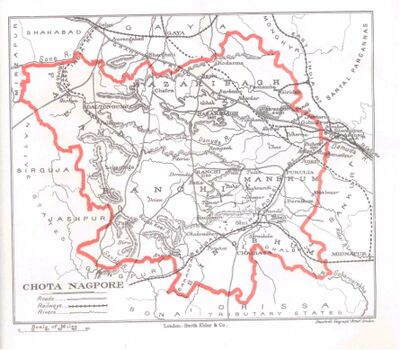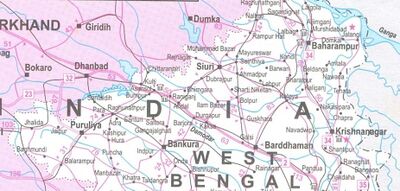Manbhum
| Author:Laxman Burdak, IFS (R) |


Manbhum (मानभूम ), present Purulia in West Bengal, was one of the districts of the East India during the British Raj. After India’s independence, the district became a part of Bihar state, and upon re-organization of the Indian states in the mid-1950s, the district became a part of the West Bengal. It is part of Chhota Nagpur.
Manbhum region has thick forests, with good mineral resources, and has a mixed demographic profile with people from different religious and social groups, including adivasis, particularly the Santhals and the Mundas.[1]
Contents
Variants
Origin of name
Jat clan
Location
Present Purulia district was carved out of the district of Manbhum.[2]
History
Kirana Suvarna was one of Buddhist Kingdoms visited by Xuanzang in 639 AD. Kirana Suvarna has been identified with Barabhum in Purulia district of West Bengal by Alexander Cunningham[3]
Alexander Cunningham[4] writes that Hwen Thsang places the capital of Kie-lo-na-su-fa-la-na, or Kirana Suvarna, at 700 li, or 117 miles, to the north-west of Tamralipti, and the same distance to the north-east of Odra or Orissa.[5] As the capital of
[p.505]: Orissa in the seventh century was Jajipur on the Vaitarani river, the chief city of Kirana Suvarna must be looked for along the course of the Suvarna-riksha river (Subarnarekha), somewhere about the districts of Singhbhum and Barabhum. But this wild part of India is so little known that I am unable to suggest any particular place as the probable representative of the ancient capital of the country. Bara Bazar is the chief town in Barabhum, and as its position corresponds very closely with that indicated by Hwen Thsang, it may be accepted as the approximate site of the capital in the seventh century. The territory was from 4400 to 4500 li, or from 733 to 750 miles, in circuit. It must, therefore, have comprised all the petty hill- states lying between Medinipur and Sirguja on the east and west, and between the sources of the Damuda and Vaitarani on the north and south.
This large tract of country is now occupied by a number of wild tribes who are best known by the collective name of Kolhan or Kols. But as the people themselves speak various dialects of two distinct languages, it would appear that they must belong to two different races, of whom the Munda and the Uraon may be taken as the typical representatives. According to Colonel Dalton,[6] "the Mundas first occupied the country and had been long settled there when the Uraons made their appearance;" and "though these races are now found in many parts of the country occupying the same villages, cultivating the same fields, celebrating together the same festivals and enjoying the same amusements, they are of totally distinct origin, and cannot intermarry without loss of caste." This
[p.506]: difference of race is confirmed by the decisive test of language, which shows that the Uraons are connected with the Tamilian races of the south, while the Mundas belong to the hill men of the north, who are spread over the Himalayan and Vindhyan mountains from the Indus to the Bay of Bengal.
The various tribes connected with the Mundas are enumerated by Colonel Dalton[7] as the Kuars of Elichpur, the Korewas of Sirguja and Jaspur, the Kherias of Chutia Nagpur, the Hor of Singhbhum, the Bhumij of Manbhum and Dhalbhum, and the Santals of Manbhum, Singhbhum, Katak, Hazaribagh, and the Bhagalpur hills. To these he adds the Juangas or Pattuns (leaf-clad) of Keunjar, etc. in the Kataka tributary districts, who are isolated from " all other branches of the Munda family, and have not themselves the least notion of their connection with them ; but their language shows that they are of the same race, and that their nearest kinsmen are the Kherias. The western branches of this race are the Bhils of Malwa and Kanhdes, and the Kolis of Gujarat. To the south of these tribes there is another division of the same race, who are called Suras or Suars. They occupy the northern end of the eastern Ghats.
छोटा नागपुर
छोटा नागपुर (AS, p.349)- इस प्रदेश का नाम, किवदंती के अनुसार, छोटानाग नामक नागवंशी राजकुमार-सेनापति के नाम पर पड़ा है. छोटानाग ने, जो तत्कालीन नागराजा का छोटा भाई था, मुगलों की सेना को हराकर अपने राज्य की रक्षा की थी. सरहूल की लोककथा छोटानाग से संबंधित है. इस नाम की आदिवासी लड़की ने अपने प्राण देकर छोटानाग की जान बचाई थी. सर जॉन फाउल्टन का मत है कि छोटा या छुटिया रांची के निकट एक गांव का नाम है जहां आज भी नागवंशी सरदारों के दुर्ग के खंडहर हैं. इनके इलाके का नाम नागपुर था और छुटिया या छोटा इसका मुख्य स्थान था. इसीलिए इस क्षेत्र को छोटा नागपुर कहा जाने लगा. (देखें: सर जॉन फाउल्टन - बिहार दि हार्ट ऑफ इंडिया, पृ. 127) छोटा नागपुर के पठार में हजारीबाग, रांची, पालामऊ, मानभूम और सिंहभूम के जिले सम्मिलित हैं. [8]
In Mahabharata
Bhisma Parva, Mahabharata/Book VI Chapter 10 describes geography and provinces of Bharatavarsha. Manavarjaka (मानवर्जक) has been mentioned alongwith Magadha as province in Mahabharata 'geography' (VI. 10.48). It is in combination of Maan + Burdak (d=j). Probably both clans ruled together. [9]
References
- ↑ Encyclopædia Britannica, Eleventh Edition, a publication now in the public domain
- ↑ Encyclopædia Britannica, Eleventh Edition, a publication now in the public domain
- ↑ The Ancient Geography of India/Eastern India, p.505
- ↑ The Ancient Geography of India/Eastern India, p.505
- ↑ Julien 's 'Hiouen Thsang,' iii.84 and 88. See Map No. I.
- ↑ Journ. Asiat. Soc. Bengal, 1866, p. 154.
- ↑ Journ. Asiat. Soc. Bengal, 1866, 158. I write Santal in preference to Sonthal, as I believe that the short o is only the peculiar Bengali pronunciation of the long ā.
- ↑ Aitihasik Sthanavali by Vijayendra Kumar Mathur, p.349
- ↑ अन्ध्राश च बहवॊ राजन्न अन्तर्गिर्यास तदैव च, बहिर्गिर्य आङ्गमलदा मागधा मानवर्जकाः (Maan+Bardak) (VI. 10.48)
Back to West Bengal